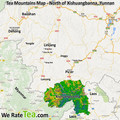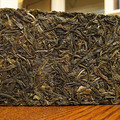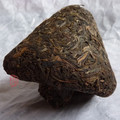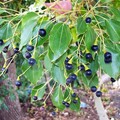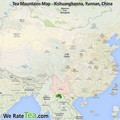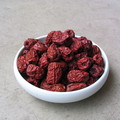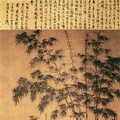Puerh Paste - Glenn McKenna
„
the creation of Puerh Paste from within Yunan Province, China. basically, it's similar to making hash or hemp oil. they brew the tea, then continue to sift it through smaller and smaller sized hole mesh bags until the final mixture is a paste. seems to me if there's a direct way to go tea infusion, this might be it.
“
Video Tags: Pu-erh, China, Tea production
- Discussion: 0 comments
- Write a comment
Teas - Pu-erh
Late 1990s "Jin Gua Gong Cha" 500g
 0 reviews
0 reviews"Jin Gua Gong Cha" also called "Tuan Cha", is a special kind of compressed puer tea. It...
2013 Chawangpu "He He" Xiao Bing Raw 200g
 1 review
1 reviewHe he is the last cake from Chawangpu 2013 spring production we offer now....
2012 EoT Bulang Puer Tea 400g
 1 review
1 reviewThis tea was a bit of an experiment for us. We'd found 2 different maochas from Bulang...
2014 Jingmai Gu Shu Huang Pian
 1 review
1 reviewThis tea is from Jingmai Da Zhai, grown in Da Ping Zhang area, and it is considered to...
Lao Banzhang 2013
 1 review
1 reviewLao Banzhang is the pu-erh that you will pay the most money for and the pu-erh that you...
Lao ManE 2013 autumn
 1 review
1 reviewThe LaoManE rules over this autumn teas. In this village you may find really bitter tea...
Quotes - Pu-erh
„The terms "Xiao shu" (small tree) and "tai di" (terrace plantation) are often interchangeably used, but they should be given separate meanings. "Tai di" connotes high intensity farming, with the entire slope cleared & terraced to plant hedgerows & use of pesticide & fertilizer. But in many gu shu growing villages, there are also new tea plantations which are too young to be called gu shu (ie. less than 100 years old), but they aren't exactly "tai di" either. Many of these plants are growing next to old trees, in a bio-diverse forest clearing, with lots of space around them, not all are sprayed & fertilized. In the future, they will grow into "gu shu", until then we should call them "shen tai xiao shu" (naturally grown small trees)“
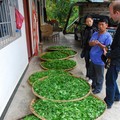
Quotes Tags: Pu-erh, Gushu, Tea production
Video - Pu-erh
Teas
NaKa 2013 autumn
 1 review
1 reviewThe Naka king makes its way with a robust and specific taste even in the autumn season. Very powerful tea...
Shu Tuocha 2003
 1 review
1 review„tailor-made” private production “Zhong Cha Gong Si” in Dayi (Menghai tea factory). This tea is made by a...
ManZhuan 2013 - blind tasting set 5
 1 review
1 reviewsweetish, rich, dense taste is apparent from the first brewing, in the second brew the fine gushu...
Theme
Tea by region
We will help you with tea selection.
Do you like quality loose tea?
We will help you to find the right one for you. Be inspired by tea ratings of other tea lovers. Rating stars could help you.


Review your cup of tea.
Review the tea you are drinking and help other tea lovers to find the right cup of tea.



Quotes
„Pu-erh shape - Bing, Beeng, Cake, or Disc - A round, flat, disc or puck-shaped tea, the size ranges from as small as 100g to as large as 5 kg or more, with 357g, 400g, and 500g being the most common. Depending on the pressing method, the edge of the disk can be rounded or perpendicular. It is also commonly known as Qīzí bǐngchá (七子餅茶, literally "seven units cake tea") because seven of the bing are packaged together at a time for sale or transport.“



 Shops
Shops Share on Facebook
Share on Facebook







